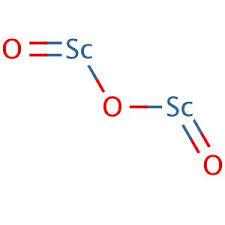CHEMICAL SUBSTANCE DATASHEET
|
CHEMICAL SUBSTANCE IDENTIFICATION |
|
|
Chemical name |
Scandium oxide |
|
Synonyms |
Scandia |
|
IUPAC name |
oxygen(2-);scandium(3+) [8] |
|
CAS No |
12060-08-1 |
|
REACH registration number |
pre-registered |
|
EC No |
235-042-0 |
|
Molecular formula |
Sc2O3 |
|
Substance group/chemical family |
|
|
Appearance Physical state Odour Form Colour |
solid no powder [1], cubic crystals [2] white [1] |
|
USES AND HANDLING ISSUES |
|
|
Relevant identified uses |
Scandium oxide is used in the preparation of other scandium compounds as well as in high-temperature systems (for its resistance to heat and thermal shock), electronic ceramics, and glass composition (as a helper material). Principal uses for scandium oxide are in solid oxide fuel cells (SOFC’s), high-strength aluminium alloys, high intensity metal halide lamps, electronics, and laser research. [3] |
|
Handling considerations |
|
|
PHYSICO-CHEMICAL PROPERTIES |
|
|
Molecular weight |
137.91 g/mol [1] |
|
Bulk density/Specific gravity |
3.86 g/cm3 [2] |
|
pH |
|
|
Particle size |
|
|
EC |
|
|
Melting point |
2485 °C [2] |
|
Boiling point |
1607° C [3](predicted) |
|
Flash point |
|
|
Flammability |
|
|
Vapour density |
|
|
Vapour pressure |
|
|
Solubility in water |
insoluble [1] |
|
Solubility in organic solvents |
|
|
Solubility in inorganic solvents |
|
|
Hydrolysis |
|
|
Ionicity in water |
|
|
Surface tension |
|
|
Dispersion properties |
|
|
Specific surface |
|
|
Stability and reactivity |
|
|
Chemical stability |
|
|
Reactivity hazards |
|
|
Corrosivity |
|
|
Polimerization |
|
|
Incompatibility with various substances |
|
|
Special remarks on reactivity |
reacts with most acids upon heating to produce the expected hydrated product [2] |
|
Physical, chemical and biological coefficient |
|
|
Koc |
|
|
Kow |
|
|
pKa |
|
|
log Kp |
2.97 (predicted) [6] |
|
Henry-constant |
|
|
ENVIRONMENTAL FATE AND BEHAVIOUR |
|
|
Artificial pollution sources |
|
|
General terrestrial fate |
|
|
General aquatic fate |
|
|
General atmospheric fate |
|
|
General persistence and degradability |
|
|
Abiotic degradation and metabolites |
|
|
Biodegradation and metabolites |
|
|
Bioconcentration |
|
|
Volatilization |
|
|
Photolysis |
|
|
Hydrolysis |
|
|
Soil adsorption and mobility |
|
|
ENVIRONMENTAL CONCENTRATIONS |
|
|
Measured data |
|
|
|
|
|
ECOTOXICOLOGICAL INFORMATION |
|
|
General adverse effects on ecosystem |
|
|
Acute toxicity (LC50, EC50) |
|
|
Aquatic systems |
Data lacking [7] |
|
Terrestrial systems |
Data lacking [7] |
|
Chronic toxicity (NOEC, LOEC) |
|
|
Aquatic systems |
Aquatic Chronic 4 (May cause long lasting harmful effects to aquatic life). [5,7] |
|
Terrestrial systems |
Data lacking [7] |
|
HUMAN HEALTH EFFECTS and PROTECTION |
|
|
Routes of human exposures |
|
|
General effects |
|
|
Endocrine disruption |
Data lacking [7] |
|
Mutagenicity |
Data lacking [7] |
|
Carcinogenicity |
Data lacking [7] |
|
Reprotoxicity |
Data lacking [7] |
|
Teratogenicity |
Data lacking [7] |
|
Skin, eye and respiratory irritations |
Irritates skin, eye, lungs, affects blood clotting. [4, 5] |
|
Metabolism: absorption, distribution & excretion |
|
|
Exposure limits |
|
|
Drinking water MAC
|
|
|
Other information |
According to the majority of notifications provided by companies to ECHA in CLP notifications no hazards have been classified. [5] |
|
Animal toxicity data |
||
|
Acute toxicity (LD50) |
Data lacking [7] |
|
|
Chronic toxicity (NOEL, LOEL) |
Data lacking [7] | |
|
ENVIRONMENTAL STANDARDS AND REGULATIONS |
||
|
EINECS regulation |
on EC list ( REACH pre-registration) | |
|
OSHA regulations etc. |
|
|
|
|
|
|
|
OTHER INFORMATION, SPECIAL REMARKS |
||
|
Classification and proposed labelling with regard to toxicological data |
||
|
|
|
|
|
CREATED, LAST UPDATE |
||
|
Created |
13th September, 2018 |
|
|
Last update |
29th October, 2018 |
|
|
REFERENCES |
||
[7] ECHA, Information on chemicals, Scandium oxide. Available from: https://echa.europa.eu/information-on-chemicals/cl-inventory-database/-/discli/notification-details/102320/838623, Accessed: 26. 10. 2018 [8]National Center for Biotechnology Information. PubChem Compound Database; CID=134661, https://pubchem.ncbi.nlm.nih.gov/compound/134661, Accessed 29. 10. 2018. |
||
